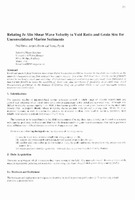| dc.contributor.author | Huws, Dei | |
| dc.contributor.author | Davis, Angela | |
| dc.contributor.author | Pyrah, James | |
| dc.date.accessioned | 2018-10-11T14:08:14Z | |
| dc.date.available | 2018-10-11T14:08:14Z | |
| dc.date.issued | 1997 | |
| dc.identifier | 11474 | |
| dc.identifier.govdoc | CP-45 | |
| dc.identifier.uri | http://hdl.handle.net/20.500.12489/429 | |
| dc.description.abstract | Recent advances in field hardware have meant that it has become possible to measurein situ shear wave velocity in the upper few decimetres of sea floor sediment in a routine manner. It is known that shear wave velocity can be primarily related to overburden depth and void ratio. Field-derived empirical relationships have previously been formulated so that it is now feasible to assess the suitability of shear wave data as a means of predicting in situ void ratio. Field measurements perfarmed on the northern Californian shelf are presented which reveal good agreement between predicted and control data. | |
| dc.format | 8 p. : ill. ; digital, PDF file | |
| dc.language | English | |
| dc.publisher | NATO. SACLANTCEN | |
| dc.source | In: High Frequency Seafloor Acoustics (SACLANTCEN Conference Proceedings CP-45), 1997, pp. 251-258 | |
| dc.subject | Seafloor sediments | |
| dc.subject | Shear waves | |
| dc.subject | Geoacoustics | |
| dc.subject | Seafloor characterization | |
| dc.title | Relating in situ shear wave velocity to void ratio and grain size for unconsolidated marine sediments | |
| dc.type | Papers and Articles | |
| dc.type | Conference Proceedings (CP) | |
